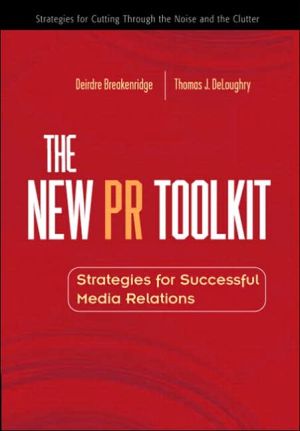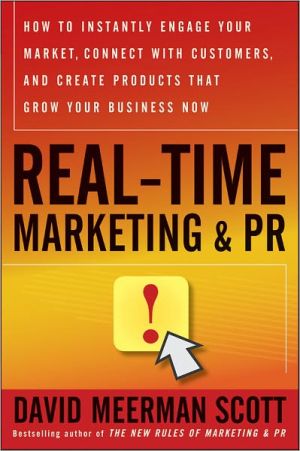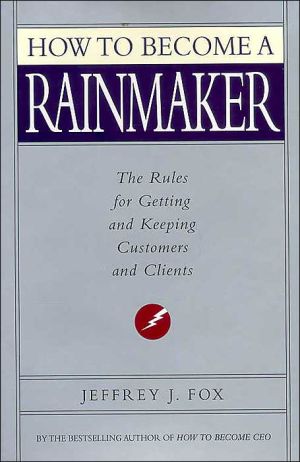The New PR Toolkit: Strategies for Successful Media Relations
The New PR Toolkit delivers proven strategies and tactics for using today's most powerful new online communications tools to strengthen any brand and every stakeholder relationship. Drawing on detailed case studies, the authors offer no-holds-barred assessments and practical guidelines for using e-mail, online newsletters, chat, Web newsrooms, online brand monitoring, and other new tools. Contains a complete blueprint for maximizing the strategic value of communications in your organization.
Search in google:
The New PR Toolkit delivers proven strategies and tactics for using today's most powerful new online communications tools to strengthen any brand and every stakeholder relationship. Drawing on detailed case studies, the authors offer no-holds-barred assessments and practical guidelines for using e-mail, online newsletters, chat, Web newsrooms, online brand monitoring, and other new tools. Contains a complete blueprint for maximizing the strategic value of communications in your organization. Soundview Executive Book Summaries Strategies For Successful RelationsBrands and stakeholder relationships need effective public relations to grow. Marketing expert Deirdre Breakenridge, an executive for an advertising and communications firm, and Thomas DeLoughry, a journalist who specializes in technology and the Internet, have teamed up to create a guide for public relations professionals from any industry to help them use the Internet more successfully and become better prepared for the PR challenges of the future. Using solid examples from companies that have used the Internet to improve their public relations efforts, the authors describe the strategies of the people who have been able to benefit from modern PR tools, including broadcast e-mails and online pressrooms. By presenting case studies that reveal the best new PR practices as well as the ones that should be avoided, the authors show companies how online strategies can be used to keep their offline work in the public eye. Doing the Legwork The first part of The New PR Toolkit explains the importance of identifying a target audience and doing the legwork to understand what it wants and needs. Using the sad tales of busted dot-coms to bolster their arguments for performing preliminary research, the authors point out that qualitative and quantitative studies that focus on the perceptions and well-being of a brand are more useful than input from secondary sources. They also describe the tools that are now available to help PR professionals gain and deliver better information. These tools include online databases, tracking software, monitoring and clipping services. The benefits of each are described through case studies and interviews with the experts. The New PR Toolkit describes in detail how modern news media works and offers strategies for using the Internet to reach them before their deadlines. Instant access is the name of the game these days, and the authors demonstrate how Web sites and e-mails can help organizations give journalists the exclusives they seek. They also offer many handy tips about how PR professionals can give reporters access to the leaders and personalities of an organization and when they should emerge from behind the monitor and shake some physical hands. Addressing the Worldwide Press Along with case studies that demonstrate effective e-mail pitches and compelling subject lines, the authors discuss the best ways PR professionals can use permission-based e-mail to keep reporters updated without being seen as spammers. They also present a blueprint for creating an effective and accessible Webcast that can put leaders out in front of the worldwide press. The authors round out their advice about online PR strategies with antidotes for the poison words that can flow through message boards and rogue Web sites that are bent on defaming a brand or a company. They also offer many crucial tips to help organizations deal with crises, as well as ways companies can appear proactive instead of defensive when difficult situations like product recalls or tragic accidents occur. In an effort to address the crucial subject of customer privacy, the authors take a close look at privacy regulations in the United States and abroad, and offer tips to help organizations keep customers informed without overstepping privacy boundaries. Why We Like This Book The New PR Toolkit is a well-planned resource for anyone who wants to know how to use the Internet to build a brand or spread a marketing message. Filled with straightforward principles about using e-mail wisely, creating online multimedia presentations, and monitoring the Internet for brand and competitor information, it presents step-by-step instructions for using modern technology to share information with the press, stakeholders and the world at large. Copyright © 2003 Soundview Executive Book Summaries
Introduction\ There's no denying that the Internet has been one of the most overly hyped technologies in human history. Newspapers, TV shows, magazines, and yes, even a few books promised us a revolutionary new business world in which hard-charging dot-coms stole markets away from established brick-and-mortar companies that were supposedly too stupid and slow moving to realize what was happening around them. All Americans would soon have personal Web pages and spend countless hours in online "communities" swapping advice with like-minded peers. Of course, that's only if they weren't running to the front door to accept deliveries of the books, toys, pet food, and sofas they bought online at low, low prices. Anyone who didn't recognize the magnitude of this Internet revolution and invest a few bucks in skyrocketing Internet stocks just didn't get it.\ Today we know that the Internet mania of the late 1990s was as much about greed as it was about innovation. Investors, sold on the notion of a worldwide network of billions of consumers, bet on startups and pushed them to run hard despite poorly formed business plans, faulty technology, and total ignorance about the difficulty of cost-effectively delivering things like groceries or bedroom sets across wide geographic regions.\ All has not been lost in the dot-com bust, however. The world has embraced this new medium of communication and it is not going to let go. The Internet might not be the megamarket previously advertised, but it has very quickly changed the way that business is done in nearly every industry—from finance to manufacturing, from real estate to retail, and most certainly in public relations.\ Indeed, itis not hyperbole to argue that the field of public relations has been revolutionized. PR professionals schooled in the old world of pretty press kits and faxed press releases have had to adapt quickly. Overnight mail is no longer fast enough. Reporters, feeling the Internet's demands for immediacy, want instant access to press releases and updated versions of corporate fact sheets, executive backgrounders, and every kind of data that PR people can make available. They expect to find the information in online newsrooms, where all these items are located in one place.\ Even more revolutionary, perhaps, is the fact that public relations people are increasingly finding themselves interacting with the public. Reporters and analysts are only one part of the job. The Internet has given customers, stockholders, prospective business partners, and others access to the materials developed by PR people. It is both a marvelous opportunity to get a client's message out to the public without the interference of reporters and a dangerously out-of-control situation in which facts, rumor, and innuendo can be circulated about a company in seriously damaging ways often under the radar of clipping and monitoring services employed to report on what's being said about a company in the press. The infamous Internet grapevine has already created big headaches for some of the country's most popular brands. From Heinz ketchup to Coors beer and even talk show hosts, such as Oprah Winfrey, no one can escape the Internet's ability to spread rumors like wildfire.\ PR people obviously have not been hiding with their heads in the sand. Most are getting press releases out quickly via broadcast e-mail and many have invested countless hours in developing online pressrooms. But who is using these tools to greatest effect? What have they learned that others in PR should emulate? What have they learned that the rest of us should avoid? What potentially helpful new tools are on the horizon? How do companies keep their online PR strategies in line with what they're doing in the offline arena?\ Our goal for this book is to answer these key questions for public relations professionals—regardless of whether their clients are new Internet companies or old manufacturers. Deirdre Breakenridge's first book, Cyberbranding (Prentice Hall, 2001), told marketers how to use the Internet to build their brands. Strong public relations was an element to that story, but The New PR Toolkit focuses intently on public relations to offer solid advice to practitioners. Despite this focus, we believe that marketing professionals, senior level decision makers, and entrepreneurs are sure to find value in the tips and case studies presented here.\ We understand that the Internet fundamentally has changed PR; however, we also counsel a strong back-to-basics approach to avoid many of the pitfalls of unsuccessful strategies of recent years. Business is still business, even if there's an e hung on the front of it. Research and planning were often the enemies of dot-com executives living on souped-up "Internet time," but both functions are actually more important than ever as PR people struggle to determine who is interacting with their brands online and offline and how can they be presented with the best possible image of the company.\ The New PR Toolkit is full of solid examples of companies that have used the Internet to improve their public relations efforts and of lessons that can be learned by some high-profile failures. Our "Odd Couple" authoring partnership (we won't identify who's Felix and who's Oscar) guarantees that readers get not only the perspectives of a PR professional who's represented clients such as JVC, GMAI, and Derek Jeter's Turn 2 Foundation, but also the views of an experienced editor who has fielded thousands of pitches and written hundreds of articles in his 15 years with respected publications such as Internet World and The Chronicle of Higher Education. PR people and reporters, whether they want to admit it or not, are partners in bringing information to readers and viewers. Our intent with this book is to point out successful strategies and tactics as seen through the eyes of the PR people who orchestrated them and the journalists who responded to them and gave the stories ink, airtime, or online play.\ The first part of The New PR Toolkit helps you to lay the groundwork for your online PR efforts, explaining the importance of identifying your target audience and understanding its needs and wants. The short lives of several dot-coms help us point up the dangers of overlooking the importance of such research. Research results, we argue, must not be derived from secondary sources, but should come from primary, qualitative, and quantitative studies focused on the perceptions and well-being of a brand.\ We tell you, the readers, about the tools available to you, running the gamut from online databases, tracking software, monitoring and clipping services, and so on, and use case studies to explain how they've been employed successfully.\ The middle part of The New PR Toolkit is devoted to explaining how the news media have evolved in the Internet era and the tools that can be used to reach them. Journalists of the 21st Century are more deadline conscious than ever, as weekly publications produce nightly electronic newsletters, and daily newspapers publish twice-daily Web updates. The historically hard-charging wire services now get their stories to the online public within minutes of their writing. The demands on their time and the power of the Internet means that many journalists consider faxes and overnight mail to be akin to the Pony Express. They want instant access to information through your Web site or via e-mail, but the details they want are the same as what they've been seeking for years. They want exclusives. They want to know in a timely fashion about big-money deals and industry-altering product announcements. They still love colorful personalities, preferably in conflict with equally colorful rivals. Getting personal access to such bigwigs is still tremendously important to most journalists and a task still best handled by PR professionals in the flesh, rather than their Internet-based tools.\ We offer specific advice and case studies to illustrate exactly how to construct effective pitches in e-mail, complete with compelling subject lines. We discuss the use of permission-based e-mail that can keep reporters updated on your company while protecting you from being branded with the odious and possibly debilitating label of spammer. We discuss the essential elements of an online newsroom and offer our advice on how to produce an effective and accessible Webcast to get your executives out in front of the worldwide press.\ In the final part of The New PR Toolkit, we focus on the pieces of a solid online public relations strategy that extend beyond day-to-day interactions with reporters or the public. We note, for example, the incredible speed of Internet communications and the importance of protecting your company from the damaging effects of message boards and rogue Web sites that spread less-than-pleasant words about your brand. As dissatisfied online users bad-mouth brands (you know the rule: have a good experience and you're likely to tell three people, have a bad experience and you tell 50 people), reporters often stumble across these postings and some might receive wider press coverage unless the affected company has a way of monitoring and intervening to protect its name.\ Another important element of an online strategy must be a crisis management capability that lets a company get information out quickly on any number of newsmaking events from plane crashes to oil spills to product recalls. The Internet audience expects to be able to go to a company's site for the latest news, which means that PR professionals need to have a ghost template ready to go live, one that is developed before a crisis occurs and can be quickly updated with the latest details and posted to the Web site. A quick online response of the type employed on September 11, 2001, by companies such as United Airlines and Sandler O'Neill & Partners can make a company appear proactive rather than defensive and can be supplemented later with materials such as written statements, legal documents, or video of the CEO's remarks that give the company's story in full.\ Another important facet of an online PR strategy, we note, is the need for integration with offline strategies. Implementing a public relations program or communication without integrating the online forum is a disservice to the brand. It's critical for the brand that is portrayed in traditional advertising in print and broadcast to be in line with what's being communicated online. Offline PR programs that increase awareness need to appear in the online forum as well. Even though brands find that they might reach different demographics online, the overall brand message needs to be consistent. Audiences who encounter offline PR receive a reinforced message when the Web site focuses on similar information. This crossover is being facilitated by the spread of high-speed Internet access, which will bring a convergence with TV and the ability to strengthen brand identity by using the same video on TV and on the Internet.\ Finally, no aspect of Internet business can be discussed without proper attention to customer privacy. No one, from the technical personnel tracking site statistics to the marketing professionals eager to create customized features to the PR people responding to e-mailed queries, should overlook the tremendous importance that many people place on their personal privacy. A law governing information gathering from children is already on the books in the United States and more laws could be on the way. The European Community, meanwhile, has promulgated tough privacy regulations that affect U.S. companies operating overseas. PR people need to acknowledge the privacy of people's e-mail addresses, for example, by not sending mass mailings in which all the recipients' addresses are visible. Even more important, however, PR catastrophes can be averted if PR people assure that privacy policies are posted online and are being followed by employees and contractors. Customer data can be used for innovations like personalization that promise to improve online experiences, but companies must be sure to have consumers' permission before rolling out such innovations.\ As we bring The New PR Toolkit to a close, we reflect on the tremendous change the Internet has made in the abilities of PR professionals to serve their constituents at any time, day or night. Although some might pine for the day when they had more control over how their clients were being discussed and perceived, there's no going back. A new communications channel has been born and we are all left to change with the times and ensure that we're doing all that we can to see that our clients are portrayed in as positive a way as merited. Some resistance to change is natural, but the new toolkit must be embraced as a means to move forward aggressively, thereby redefining the P in PR to mean "proactive."With the end of the Internet frenzy and the onset of tough economic times, no one, not even deep-pocketed brands like Procter & Gamble or General Electric, is going to throw unlimited dollars at their online efforts. PR professionals need to ensure that what's spent is spent correctly by being proactive, doing accurate research, developing the appropriate strategies, staying on top of their execution, and managing a brand's reputation to guarantee the best possible outcomes for their clients.
AcknowledgmentsIntroductionPt. IPeople, Profit, Politics, and Process1Ch. 1Who's a Kingmaker?3Ch. 2The Seismic Shift9Ch. 3A Word About Profit21Ch. 4Politics at Large27Ch. 5Politics in the Day to Day35Ch. 6Losing Like a Winner47Ch. 7Ego, Fear, and Competition57Ch. 8The Responbility of Leadership67Ch. 9The Champion75Ch. 10Embrace Diversity81Summary of Part I: People, Profit, Politics, and Process89Pt. IIExcel, Execute, Enjoy!91Ch. 11Value Yourself If You Intend to Be Valuable93Ch. 12How Can You Affect the Company's Margin?103Ch. 13Become Your Manager's Go-To Person111Ch. 14Getting a Handle on Obsession and Defensive Action117Ch. 15When Is It Okay to Break Rank?129Ch. 16Interview Discovery137Ch. 17How to Pick (and Get Along With) Your Boss145Ch. 18Management by Type153Ch. 19Preparing for Your Annual Review: Managing Your Value Perception167Ch. 20Keeping Clear on What You Think You Want175Summary of Part II: Excel, Execute, Enjoy!181Pt. IIIPlanning for Passion and Prosperity185Ch. 21Branding Yourself: The Art of Free Agency187Ch. 22Achieving Fulfillment Through Great Work199Ch. 23Letting Go and Having a Life207Ch. 24The Freedom Plan213Ch. 25When Leaving Is the Only Answer231Summary of Part III: Planning for Passion and Prosperity237Ch. 26Your Personal Value Kingdom241
\ Soundview Executive Book SummariesStrategies For Successful Relations\ Brands and stakeholder relationships need effective public relations to grow. Marketing expert Deirdre Breakenridge, an executive for an advertising and communications firm, and Thomas DeLoughry, a journalist who specializes in technology and the Internet, have teamed up to create a guide for public relations professionals from any industry to help them use the Internet more successfully and become better prepared for the PR challenges of the future. \ Using solid examples from companies that have used the Internet to improve their public relations efforts, the authors describe the strategies of the people who have been able to benefit from modern PR tools, including broadcast e-mails and online pressrooms. By presenting case studies that reveal the best new PR practices as well as the ones that should be avoided, the authors show companies how online strategies can be used to keep their offline work in the public eye.\ Doing the Legwork\ The first part of The New PR Toolkit explains the importance of identifying a target audience and doing the legwork to understand what it wants and needs. Using the sad tales of busted dot-coms to bolster their arguments for performing preliminary research, the authors point out that qualitative and quantitative studies that focus on the perceptions and well-being of a brand are more useful than input from secondary sources. They also describe the tools that are now available to help PR professionals gain and deliver better information. These tools include online databases, tracking software, monitoring and clipping services. The benefits of each are described through case studies and interviews with the experts.\ The New PR Toolkit describes in detail how modern news media works and offers strategies for using the Internet to reach them before their deadlines. Instant access is the name of the game these days, and the authors demonstrate how Web sites and e-mails can help organizations give journalists the exclusives they seek. They also offer many handy tips about how PR professionals can give reporters access to the leaders and personalities of an organization and when they should emerge from behind the monitor and shake some physical hands.\ Addressing the Worldwide Press\ Along with case studies that demonstrate effective e-mail pitches and compelling subject lines, the authors discuss the best ways PR professionals can use permission-based e-mail to keep reporters updated without being seen as spammers. They also present a blueprint for creating an effective and accessible Webcast that can put leaders out in front of the worldwide press.\ The authors round out their advice about online PR strategies with antidotes for the poison words that can flow through message boards and rogue Web sites that are bent on defaming a brand or a company. They also offer many crucial tips to help organizations deal with crises, as well as ways companies can appear proactive instead of defensive when difficult situations like product recalls or tragic accidents occur.\ In an effort to address the crucial subject of customer privacy, the authors take a close look at privacy regulations in the United States and abroad, and offer tips to help organizations keep customers informed without overstepping privacy boundaries.\ Why We Like This Book\ The New PR Toolkit is a well-planned resource for anyone who wants to know how to use the Internet to build a brand or spread a marketing message. Filled with straightforward principles about using e-mail wisely, creating online multimedia presentations, and monitoring the Internet for brand and competitor information, it presents step-by-step instructions for using modern technology to share information with the press, stakeholders and the world at large. Copyright © 2003 Soundview Executive Book Summaries\ \ \








